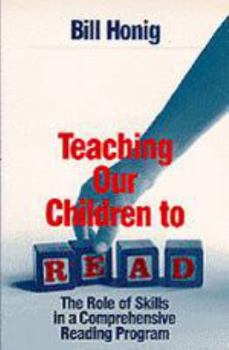Teaching Our Children to Read: The Role of Skills in a Comprehensive Reading Program
One of the major concerns in education is the number of children who have a low comprehension of what they read. Many approaches have been adopted over the decades in an attempt to redress this situation - including phonics, discrete skill training and whole language - largely without success. Recent research indicates, however, that the most effective solution combines all three of these approaches. Bill Honig makes a strong case for a balanced approach to teaching reading in nursery school and primary school, and provides a step-by-step guide to the reading skills that should be introduced and mastered in each grade.
Format:Paperback
Language:English
ISBN:0803964056
ISBN13:9780803964051
Release Date:December 1995
Publisher:Corwin Publishers
Length:160 Pages
Weight:0.50 lbs.
Dimensions:6.0" x 9.0"
Customer Reviews
1 rating
What administrators forgot to include in Whole Language.
Published by Thriftbooks.com User , 28 years ago
A book that details what Bill Honig, the former California State Superintendent of Education, took as a given in the hearts and minds of administrators in California when he initially suggested incorporating the "Whole Language Literature-Based" approach to reading instruction. The outline above gives you an overview of the areas that mid-level administrators chose to throw out in "implementing" what were meant to be the supplemental suggestions of Whole Language.In addition to spelling out the basics for a generation of teachers who missed (or were forbidden to use) them, this book details the horror that Mr. Honig felt after seeing ideas meant to improve an already existing and workable system egregiously misapplied by the buzzword harpies of the midlevels of the educational establishment fluttering from one new idea to another without a sense of continuity or connection, in a rush to appear intellectually modish and to appear to bring their districts "into compliance with" state educational standards, but who had gotten their information not from the source, but from diluted summaries, memos, and seminars. Under what Whole Language came to be after this trickling down of misinformation, we saw principals entering classrooms and seizing the old grade-level spellers that teachers hid like contraband in the bottoms of their desk drawers. Hopefully this book will bring awareness of the balance between phonics and contextual cues that make up reading skills by warning those who read it of the dangers of shrieking "Out with the old! In with the new!" and do something to now help retain the good that is to be found in Whole Language while reinstituting the basic skills that precede the ability to make guesses about the text, which then precedes the ability to draw meaning from and make inferences about the text. The question remaining is: Are there now enough people out there with the ability to read and understand the book





